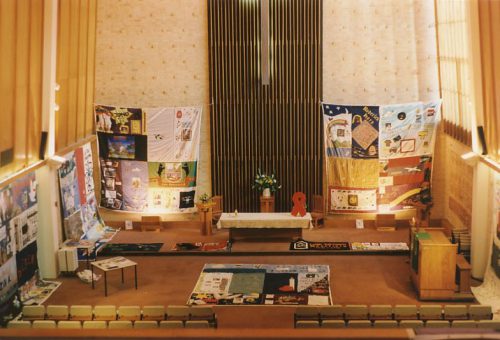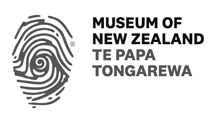Jono
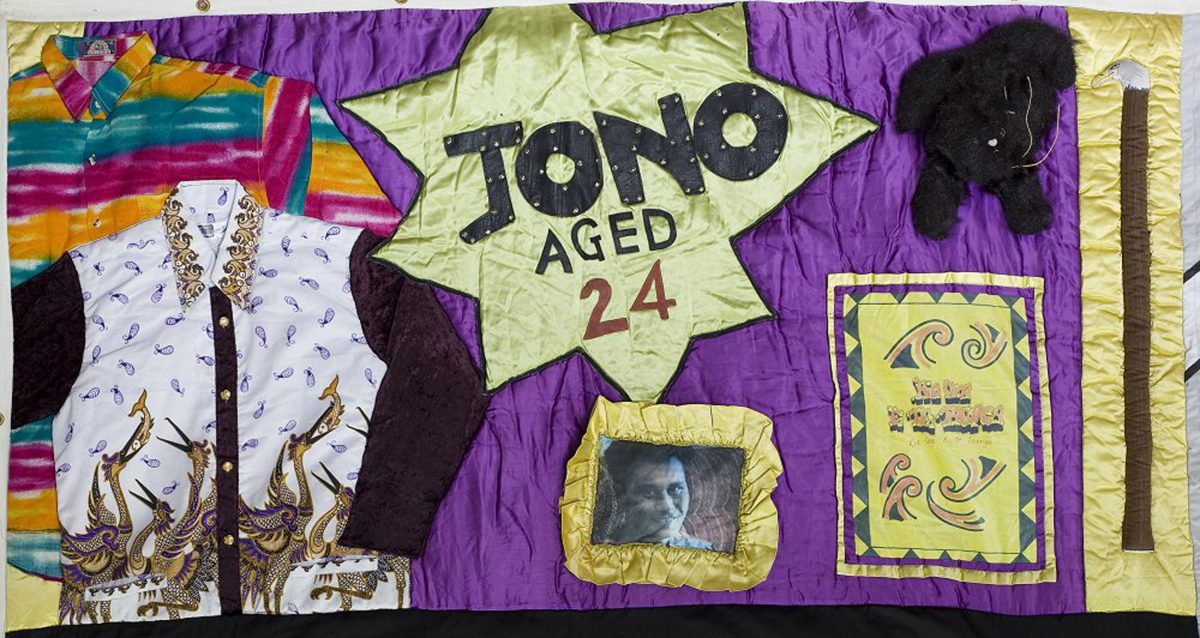
Jonothon O’Keefe
James Henry Keefe
“Pretty Boy”
Jono’s Quilt panel has colourful shirts.
A copy of a thank you poster from students he spoke to.
A black cat.
His age.
The panel’s colour is yellow and purple satin.
The panel was created by extended whanau, friends and NZ AIDS Foundation (now Burnett Foundation Aotearoa) Ettie Rout staff and volunteers.
Add a memory to this panel
If you wish to add your memories to this page, please get in touch.
Nicholas

This panel arrived with only a card saying:
N I C H O L A S
Died 27 September 1994
Dearly Loved
We believe the panel is for Nicholas Hay who died on this day
Add a memory to this panel
If you wish to add your memories to this page, please get in touch.
Stuart Mace
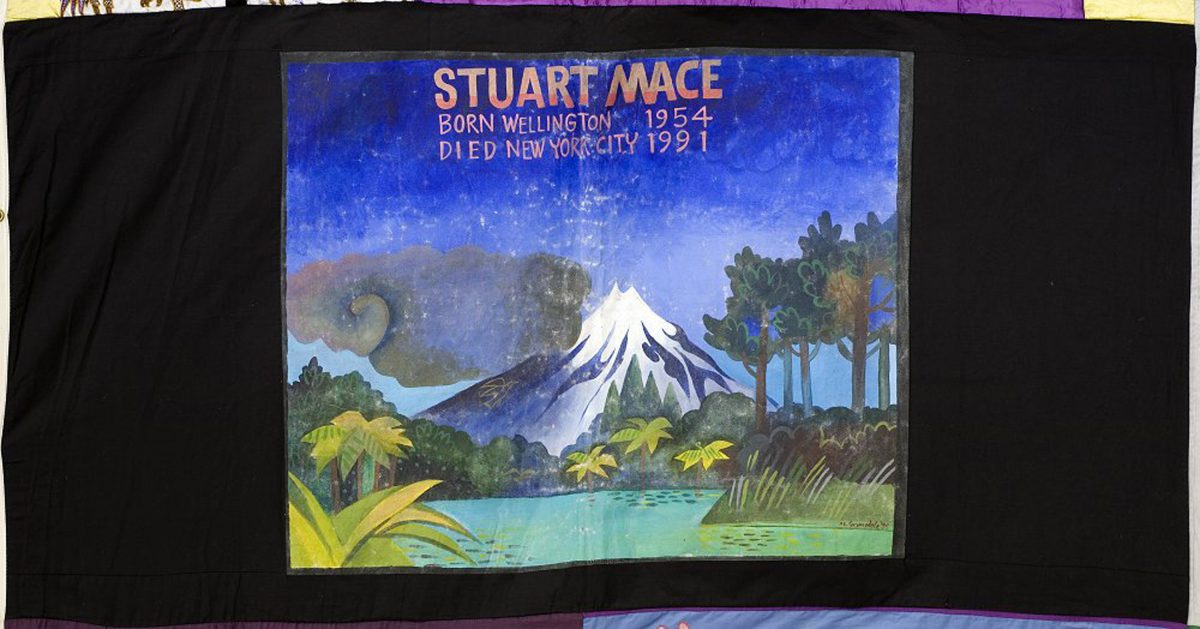
Our dearly loved son, brother, uncle and friend, Stuart, grew up on the eastern slopes of Mt Egmont. At about the age of 17, while at university, he came to the realisation that he was gay. Because of the homophobia in New Zealand at the time, once he finished his degree, he moved to London where he spent several years before heading to the big metropolis of New York. It was there he contracted HIV.
I will always remember the way he didn’t blame his partner but took responsibility for himself by saying he should have been more careful.
A caring, generous man, he gave his final months to counselling those living with AIDS. He introduced us to many wonderful friends and to a city full of caring AIDS workers. He died in New York City on 15 December 1991 at the age of 37 with myself, his sister, and our mother at his side.
This piece is dedicated in loving memory by his family and New Zealand friends. It was painted by Murray Grimsdale, a gay Auckland artist and illustrator of books, including school journals. The painting was commissioned by his and our friends, Jeffery Buchanan and Stuart Watson.
Arohanui, Stuart.
Add a memory to this panel
If you wish to add your memories to this page, please get in touch.
Jeffrey Alan Fortune

This panel is in loving memory of our dear son, Jeff. It has been put together mainly by myself but other members of the family have also helped by adding their pieces of work and written messages.
For me, as Jeff’s mum, it has been a privilege to have been part of this panel and I spent many hours thinking and wondering how to get started. We had no idea what other panels were like and only know it had to be a certain size.
However, with the help of my husband John, we came up with the plane, as Jeff’s first passion was flying, and then his photo and dates. We just went from there with no set plan until we felt it was complete.
When he was very ill, he did say to me that he would like to be part of The AIDS Quilt so I was determined to follow through with his wish, and nearly one year later (October 1996) we pass on to you our most treasured panel.
Jeff was the youngest of 4 children, one older sister and 2 brothers. He and I were very close and I loved him so very much.
What was special about Jeff? I would undoubtedly have to say “his expression of love”. He was a great lad in phoning up and always ending up by saying, “I love you, Mum”. He was a very loving person and this, to me, made him very special.
We, as a family, have learned a lot from having Jeff in our lives and we will be eternally grateful for having had the chance to know him and love him. He will live on in our hearts forever and we know he is close by.
We felt the tartan was appropriate as Jeff’s father is a Scotsman.
Thank you all for accepting our panel.
Norma Fortune and family.
Add a memory to this panel
If you wish to add your memories to this page, please get in touch.
Richard Michael Noonan

Richard was born three months after his older sister, Geraldine had passed way, which made him very special to his family. He was educated at St. Patricks Convent School, Kaponga, a town with about 500 people on the south side of Mt Taranaki, New Zealand.He was a very studious young man and wanted to go to New Plymouth Frances Douglas College run by the De La Salle Brothers. He enjoyed his school years.
On leaving school he worked at the Hawera Taranaki Savings Bank for four years and lived in a flat. As he wanted nice things for his home, he also worked as a barman at the then Central Hotel, two nights a week and at the T.A.B. on Saturdays. He wasn’t afraid of work. But banking wasn’t to be his career.
He left New Zealand for the big smoke Sydney, where he started out in Foreign Exchange then joined Thomas Cook Travel at Centre Point. Travel is what he loved and was very popular with his clients. This was a young man who always cared about others.
After four years he decided home and family were calling, which was to the delight of his family and friends. He came back to New Plymouth, working as a travel consultant for Thomas Cook by day, and Maitre D of the then Devon Motor Lodge by night. He was very good at restaurant work. Also, when needed, he would work with I.H.C. people at the Waitara residence and at New Plymouth so it was not often that he took time out for himself.
His family loved having him living so near. Family always came first with Richard, especially his grandparents whom he loved dearly. His sister, Michelle and Richard were very close and were always able to confide in each other. There was only a year between them and they were very good mates.
Michelle married Dwane and their three children, Dyllan, Sarah and Emma loved him dearly. He was like Father Christmas, always bringing home presents and taking them to parks etc to do interesting things.
Richard’s brother Willy and his wife Judi-Anne have four children, but only the oldest, Johnathan remembers his uncle. We tell them all about him and they say he is that bright light in the sky. Richard and Willy were just getting to know each other again when Richard was diagnosed as having HIV. This made Michelle and Willy very angry. This wonderful brother was going to die.
For Richard to tell his parents that he had the Virus, and that he may only have 18 months to live was the most stressful thing he’d ever had to do. He actually came home three days before he could do it. It was after he had almost lost his life to pneumonia, unbeknown to his family, that he felt he could put it off no longer.
He taught us so much about his sickness, and educated us all in how to cope and understand others with the virus. He started public speaking in Auckland at lots of meetings ‘living with AIDS’, which helped so many people. He also spoke on death and dying.
This man was a prince among men and wanted people to know this disease is out there and that it kills.
When he was diagnosed with the virus he was working with Jet Set Travel in Auckland. He knew his sight was deteriorating and he was getting so tired, he finally had to leave his job. Richard wasn’t going to give up though, he said with all his knowledge there must be someone out there who would employ him. He met a lady who was opening a restaurant and as he had the experience she gave him a job at Beauchamps Restaurant. Richard was so grateful to his boss for giving him this chance to continue leading a useful life for what time he had left.
He set himself a goal to work until the week before Christmas. He would stay in bed all day, then get up and shower and dress. His Aunty Teresa and his mother would beg him not to go, but if you knew Richard, come hell or high water, he would reach his goal. We don’t know how he even got to work, let alone got through the night, but he did. On the final night he was so pleased he had succeeded, I guess it was self-satisfaction.
In a couple of days he packed his car and went home for his last Christmas with his nieces and nephews. He brought out present after present. I think he was making up for not being around to see them grow up.
His flatmates in Auckland were so supportive, his mother would go to Auckland every time he became ill and lived in his room and helped nurse him. Then he would go back to Takapuna to his Aunty Teresa, Uncle Phil and Adriane who always had the time to care for him (it was his home as long as he needed it). Richard and his mum would have much trouble managing. It’s these kind of people that are hard to find. Uncle Phil even used to wash and clean his car while Richard would sit and watch, unable to help.
Aunty Paula would have him at her flat and would care for him for which he was so grateful. Since Richard’s death his Aunt was killed tragically in a car accident.
This man was special to his Aunts and Uncles, cousins and extended families (very numerous).
It was probably harder for Richard’s dad, sister and brother as they had to stay in Taranaki and couldn’t be there for him (it wasn’t possible to all be in Auckland). However, they did make it within Richard’s last few days and he died in peace with so much love. His friends kept a vigil at Mercy Hospital around the clock which meant he was never alone.
After reading this I hope you look at his Quilt and feel you know this young man,
OUR SON
THE QUILT
The Mountain represents Taranaki, where Richard spent most of his life.
The Goldie photographs are his Maori heritage, of which Richard was very proud. He was from the Ngati-Tama tribe.
The racing car modified 10s is well known throughout the country. Richard always attended Waikaraka Park when Willy was racing, even when he was ill. He knew Willy would become a New Zealand Champion, and the year after Richards death Willy became New Zealand Sportsman of the year.
The fuchsias are his mother’s love, around the family home you will always find these flowers.

Mikki-tae has this to say about Richard:
Untie was his name to us, it was given as a mark of respect. Untie treated us like his own, he was caring and very generous always giving good advice and ready with a cuppa tea or a welcoming karanga when we came to visit him at his Sydney, Oxford street Paddington flatette. Just enough room for his fold out bed but always enough room for all of us to crash the night after a night out.
Some Sunday afternoons we would meet for lunch at his whare, enjoy a few drinks and waiata and when we got too loud he would muster us up and we would walk down to the Aubury Hotel singing waiata’s; you can picture Untie the tall fair curly hair one and myself, Greg, Joe, Brendon and Trash. We knew we were always safe around Untie.
I remember two of his dearest friends, James, who was a hairdresser for the rich and famous and Polly, who was so theatrical I’m sure Untie wanted to murder him at times, but they all got on like a house on fire.
I missed Untie when he decided to return home; we all knew that he was HIV positive. I was happy he did return to his whanau because they were everything to him.
Thank you my darling Untie, I have made you proud, my life is all I have wanted and I have been with my Tane for 27 years, we recently had our civil union and have been living back in Aotearoa for a while.I always think of you when any thing that associates Taranaki comes to mind. Greg & Don are well and very happy in Dublin; you will be proud of them both. Trash is happily coupled now with Clyde for over 15 years. Thank you for your generosity aroha be forever embedded in us your nieces.
Moe moe ra, haere atu ra haere atu ra………
Added July 2013
Add a memory to this panel
If you wish to add your memories to this page, please get in touch.
Ian George Vile
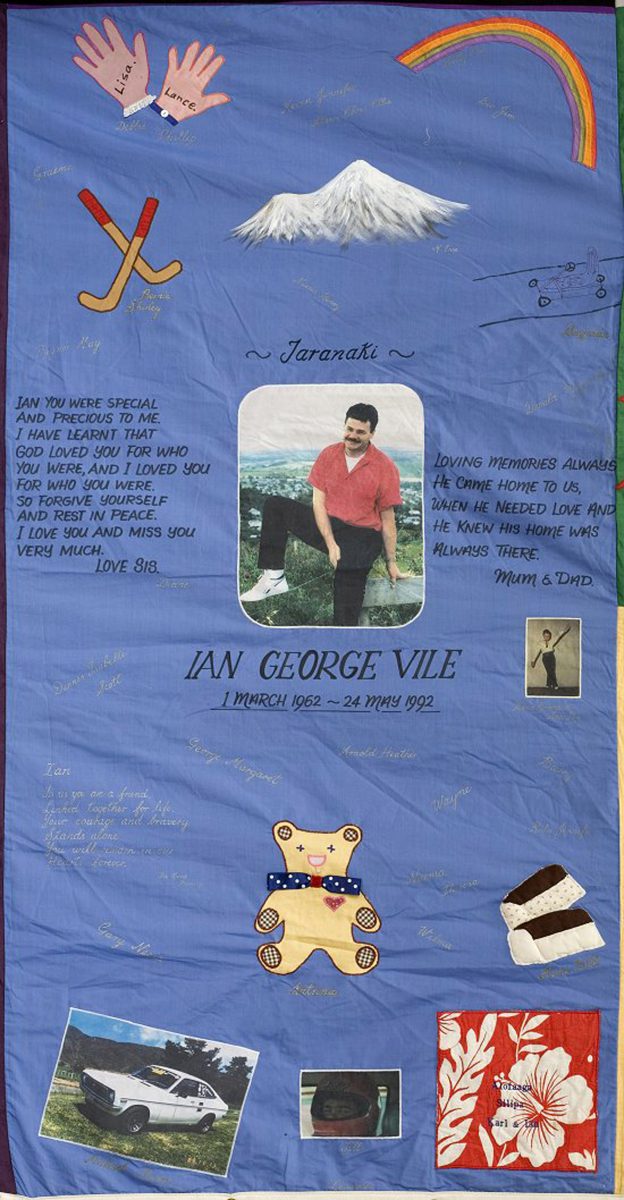
This Quilt is a memorial to Ian, youngest son of Barbara and Trevor Vile of New Plymouth.
Ian was born in Eltham. He attended Eltham Primary and Stratford High School.
As a child he enjoyed hockey and tap dancing.
He began his working life at Spinay Motors, Hawera.
He continued playing hockey when he later lived in Auckland and Palmerston North.
He also built his own 120-C car and raced it.
Ian enjoyed life to the full.
The Quilt was thought of, then arranged and sewn by Betty Chainey.
Autographing was done by Colleen Simpson, and Mt Egmont painted by Marilyn Earp.
The Samoan panel was jointly worked by Ian’s flatmate and his nurse in Palmerston North.
An adopted Dutch aunt from Auckland contributed the loaves of bread.
The teddy bear and go-cart were made by Ian’s nephew and niece.
The remaining work was the combined effort of friends and family.
Add a memory to this panel
If you wish to add your memories to this page, please get in touch.
Tom O’Donoghue
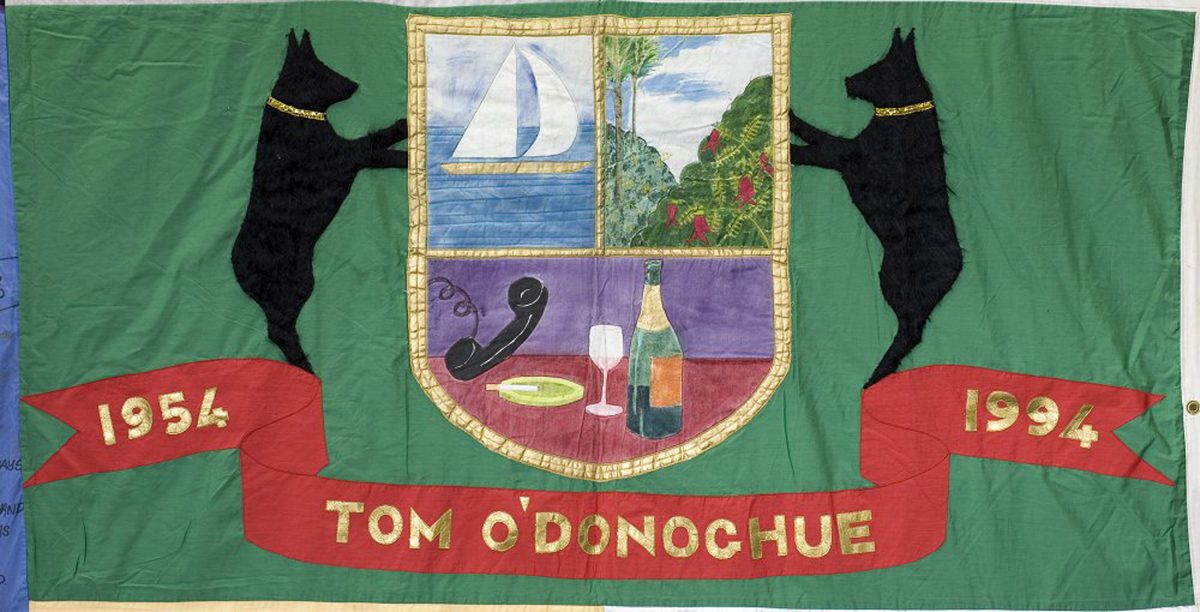
In March 2015, Kim Scholey sent us the following information about Tom’s Panel:
The green background acknowledges Tom’s Irish ancestry.
The two Schipperke dogs represent Wallis and Jojo who loyally accompanied Tom as his coffin as was finally carried down the 110 steep steps and winding path of his house on 1st October 1994. They are fabricated from a black mohair scarf of Tom’s.
The native plants, including Kaka Beak are to do with Tom’s interest in growing New Zealand native plants.
The yacht is a reference to Tom’s love of sailing, which began during his childhood in Paihia and continued with his trans-Atlantic crewing adventures.
The cigarette, telephone and glass of wine are a reference to Tom’s habit of long chatty conversations in his Wadestown (Wellington) kitchen, with a cigarette burning and a glass of wine in his hand.
From the stories folder that accompanies The Quilt to displays
From City Voice
A beacon of hope was dimmed last week when Tom O’Donoghue died at his home in Wellington of AIDS, the disease he devoted the last few years of his life to preventing.
Diagnosed HIV positive in 1988, Tom was one of the first New Zealanders to stand up and say so, combining his personal experience and his background as a health worker to take the prevention message to the community.
A gifted communicator, he was equally at home whether pushing his theme to at-risk homosexual men, sex workers and injecting drug users, or to politicians and bureaucrats.
“If I can prevent just one person from getting this disease then it will have been worthwhile” was his driving principle, a motivation which saw him carry on even when it was clear his own illness was taking its toll.
His funeral, held at a packed Old St Paul’s last Saturday, was clear testimony to the number and diversity of people he had reached out and touched.
Speaker after speaker paid tribute to Tom’s contribution to their own understanding and acceptance of the virus, speaking of him as teacher, friend, support and a light in their darkest hour.
Many in Wellington knew him from work at the upper Cuba St premises he shared with the Prostitutes Collective and the Wellington Information and Drug Education group. It was a base he chose, he said, because he did not feel rejected or marginalised there.
He also worked in prisons, lectured to police recruits, conducted radio talkbacks, spoke to health professionals, community groups, schools and through the media.
Tenacious in his beliefs and untiring in his efforts, he was also a warm and humourous man who leavened the solemnity of his message with charm and wit.
He was a persistent political lobbyist, enormously pleased when Human Rights legislation was broadened last year to outlaw discrimination on the grounds of sexual orientation or health status.
Tom co-founded the National People Living with AIDS Union, was a member of the government’s advisory National Council on AIDS, and a trustee of the NZ AIDS Foundation (now Burnett Foundation Aotearoa).
Despite his worsening illness he refused to become self-absorbed and retained till the end his interest in and compassion for others. He will be missed by many.
Tom is survived by Kim, his partner of 10 years.
We have also got this Press release from the New Zealand AIDS Foundation
Issued by the New Zealand AIDS Foundation, 28 September 1994One of New Zealand’s leading AIDS campaigners, Tom O’Donoghue, died today at his home in Wellington with an AIDS-related condition.
“Tom’s contribution to community understanding of AIDS is incomparable. We have lost a unique and inspirational figure – a man who was loved and respected by everyone who worked with him,” says Warren Lindberg, Director of the New Zealand AIDS Foundation (now Burnett Foundation Aotearoa).
Tom was one of the first people in New Zealand to publicly acknowledge his HIV status and a powerful advocate for people living with HIV and living with AIDS.
Tom was a founder member of the National People Living With AIDS Union and Collective Thinking, a publication for people living with, or affected by, HIV/AIDS. He was a trustee of the New Zealand AIDS Foundation until 1991 and had many links with other community organisations throughout New Zealand, including new Zealand Prostitutes Collective and organisations working with injecting drug users.
Tom was a popular and powerful educator in the wider community too, through his work in prisons, in the north where his family live, with the media and at public events like last May’s Wellington Beacons of Hope ceremony.
Then, Tom spoke of “the enormous relief” he felt when he first publicly acknowledged he was HIV positive and the need for people to speak out about HIV and its effects, particularly within our gay community.
“Let us no longer be burdened by dishonesty.” he said. “Let us be the best educators in the field of HIV/AIDS because only we can personalise this virus. The prejudice and stigma still exist because of the nature of HIV being a sexually transmitted disease. But disclosure can lead to enormous personalised reward, and the benefits to the community of increasing our visibility and stopping the spread of this virus are huge.
Warren Lindberg: “Everyone in the New Zealand AIDS Foundation mourns his loss. We extend our heartfelt sympathies to those who knew Tom, particularly his partner Ken. Tom’s courage when faced with AID, and his immense contribution to creating a more supportive environment for those living with HIV/AIDS and those at risk, is nothing short of inspirational.”
The Prostitutes Collective and the Injecting Drug community in Wellington published this in their joint periodical:
Tom was a crusader for the rights of people living with HIV and AIDS, injecting drug users and sex workers.
In the five years he spent with us, he taught us many things. He was one of the few people who was able to put a face to AIDS. He accessed all kinds of people at all levels. His opening line would be, “Hi, I’m Tom, and I’ve got AIDS.” Incredibly the doors would open.
He provided advice for Government Ministers (developing a special rapport with the Hon. Katherine O’Regan). Government departments were often visited by Tom. The Lifestyle Changes Programme for prison inmates and Officers was started by Tom and he worked closely with Justice employees.
He also taught us all in the way he lived and his interaction with all sorts of different people. Tommy showed us that living with the HIV virus was just that . . . living. He dispelled any misconceptions/myths that people might have had about the virus and those living with HIV/AIDS.
Besides Tom the Campaigner, we will always remember the cheeky/naught Tommy and his personal insights with everyone he met. Hi little giggles and the way his eyes would twinkle when he would say, “I hope you don’t mind but . . . ”
Because of who Tom was and what he meant to us, Tom will remain a part of us for a very long time.
In March 2014, Simon, from Adelaide, Australia, wrote:
Add a memory to this panel
If you wish to add your memories to this page, please get in touch.
Ian Thompson
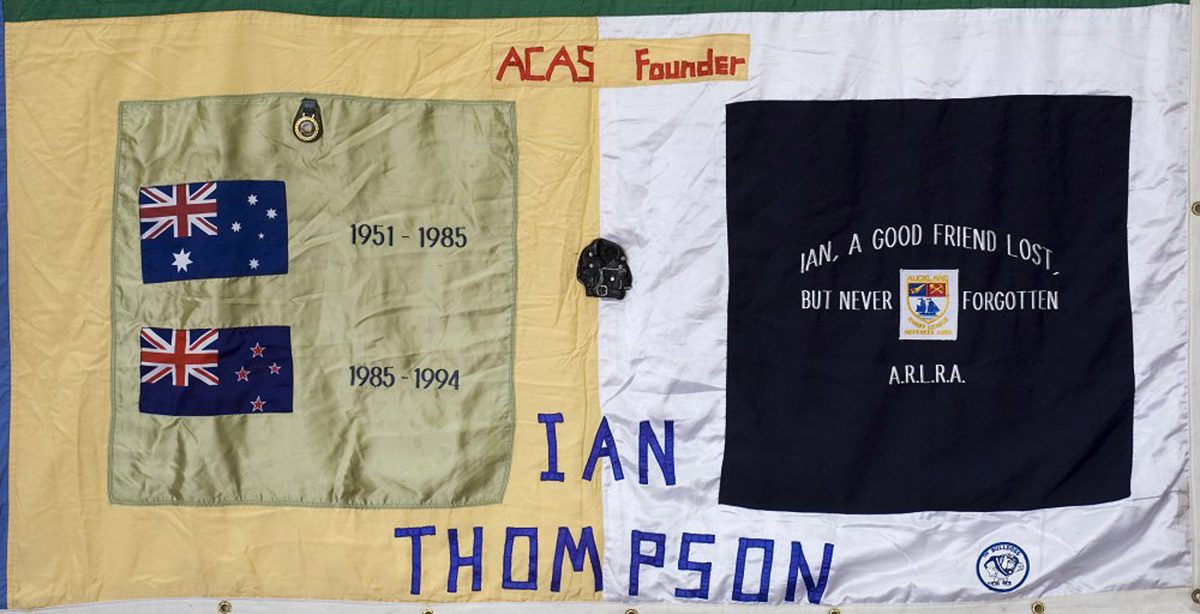
Tommo
One of New Zealand’s gay community’s most colourful personalities, Ian was also a tireless worker in the area of HIV and AIDS support, and was the driving force behind the establishment of Auckland Community AIDS Services (ACAS) of which he was the first Chairperson.
He also served on the Board of the NZ AIDS Foundation (now Burnett Foundation Aotearoa) representing the HIV positive community, and was one of the founding members of the Gay Auckland Business Association (GABA). He was well known for his questioning of where monies raised from fundraising was spent.
Ian was a man with an ‘up front’ personality, who made a mark on both the Auckland and wider New Zealand community institutions, often in the most controversial of areas, and strongly affected what that community became.
With a Scottish heritage, Ian was raised in Sydney, moved to Auckland in the early 1980’s where he eventually took out New Zealand citizenship. He came to dearly love his adopted city and committed himself to many causes that aimed to improve the lot of gay and lesbian people who live in it.
For ten years Ian worked for OUT! Magazine, running the accounts department as well as helping out where ever he was needed in the community. He was a person concerned with the practical outcomes and his direct approach brought people together and ensured that services worked for the benefit of people they were intended for. He was often found helping out behind the front desk or bar at various community venues throughout central Auckland.
He believed strongly that New Zealanders’ were a very fair people, and was fond of putting forward examples of where people had been ready to reassess their point of view once they are presented with the facts.
His interests also encompassed the world of Rugby League and he became a very highly respected senior referee of the sport and eventually held the position of secretary of the Auckland Rugby League Referees Association.
| GREEN AND GOLD | for the country of Ian’s birth; Australia |
| NAVY | for the sport he loved; Rugby League with his referee’s badge and the badge of the Canterbury Bulldogs team he followed (Canterbury Bankstown, Ian’s place of birth) |
| ACAS | the support organisation Ian helped start for people with HIV and AIDS |
| Scottish Clan Crest | the crest of his ancestors, the clan of his parents |
| Leather jacket | Ian loved his leather |
We have also received this photo of Ian.

Add a memory to this panel
If you wish to add your memories to this page, please get in touch.
Other photos of this block
Panels in this Block
| Panel Name | Life Years | Panel Link |
|---|---|---|
| Ian George Vile | View Panel › | |
| Ian Thompson | 1951 - 1994 | View Panel › |
| Jeffrey Alan Fortune | 3 April 1966 - 9 November 1995 | View Panel › |
| Jono | View Panel › | |
| Nicholas | View Panel › | |
| Richard Michael Noonan | 25 September 1961 - 25 February 1992 | View Panel › |
| Stuart Mace | 1954 - 15 December 1991, aged 37 | View Panel › |
| Tom O’Donoghue | 3 June 1954 - 28 September 1994 | View Panel › |
